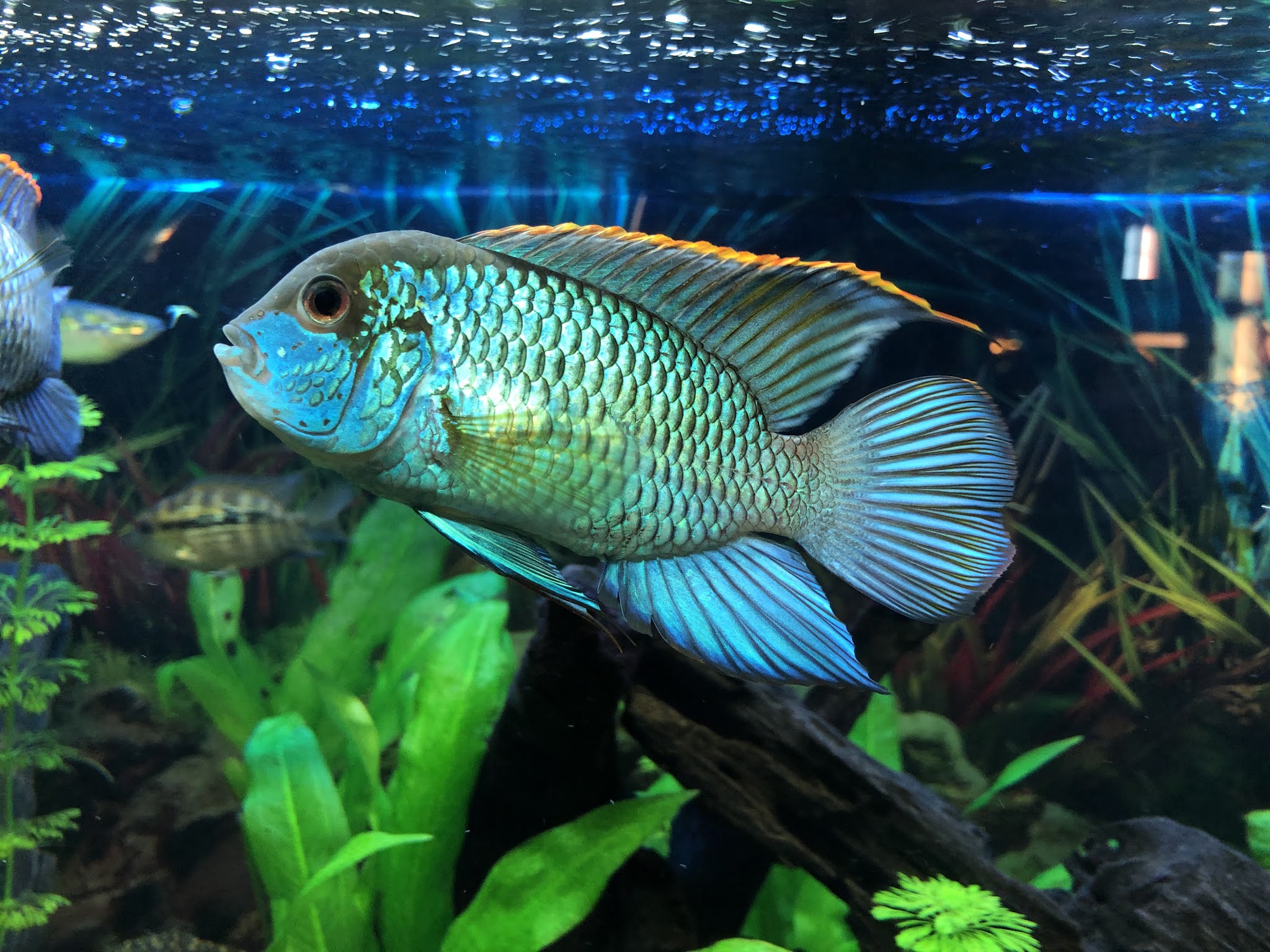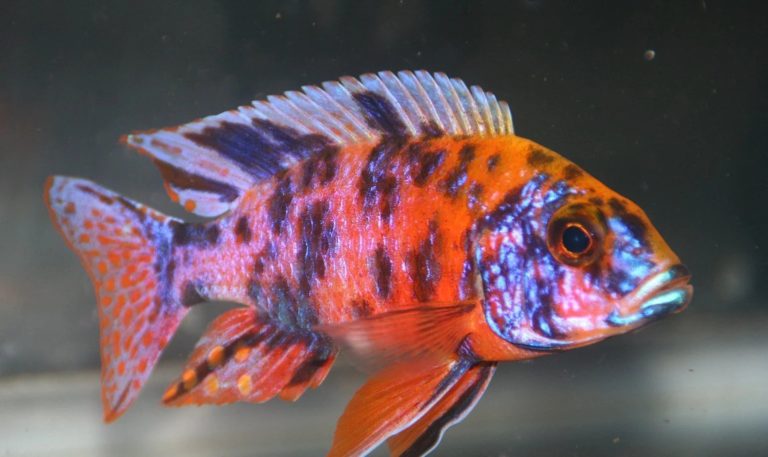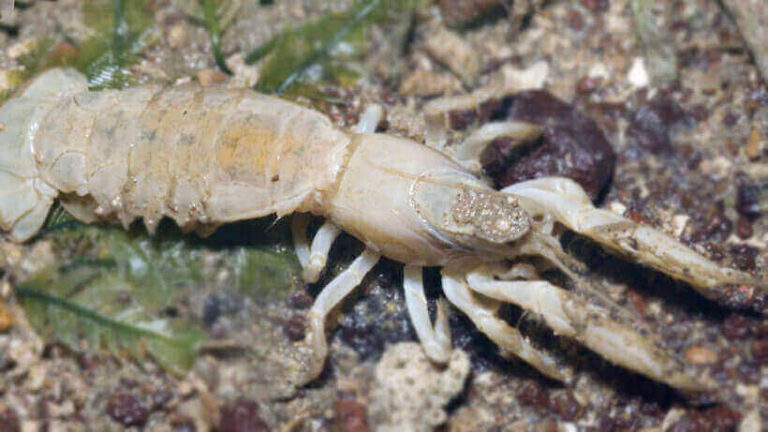Electric Blue Acara
Electric Blue Acara (Andinoacara pulcher) is a color variant of the Blue Acara, a South American cichlid. This fish is well-liked among aquarists due to its beautiful coloration, peaceful temperament, and relative ease of care.
Electric Blue Acara Fish Species Summary:
| Scientific Name: | Andinoacara pulcher |
| Origin: | Freshwater sources of South America |
| Diet: | Omnivore (feeds on a variety of foods including dry pellets, frozen foods like brine shrimp and bloodworms, and vegetable matter) |
| Behavior: | Peaceful, but can be territorial during breeding times |
| Behavior Towards Their Own Species: | Relatively peaceful, but may become territorial during breeding |
| Swimming Zone: | Middle to Bottom |
| Water Temperature: | 22 – 28 °C |
| Water Hardness: | 6 – 20 GH |
| pH Level: | 6.5 – 7.5 |
| Minimum Aquarium Volume: | 113 Liters (30 gallons) for a single fish, but larger (189-227 Liters or 50-60 gallons) is preferred for a pair or community |
| Adult Size: | 15 – 20 cm |
| Reproduction: | Substrate spawner, lay eggs on flat surfaces and both parents care for eggs and fry |
| Lifespan: | 8 – 10 years (with proper care) |
| Care: | Moderate, requires a well-balanced diet, regular water changes, and sufficient hiding spaces. |

Tank Size
The Electric Blue Acara is an active fish that enjoys swimming and requires ample space to thrive. For a single Electric Blue Acara, a 30-gallon tank is the minimum size recommended to provide adequate space for swimming and territories. However, if you plan to keep a pair or a community of fish, a larger tank of 50-60 gallons is preferred. This will ensure each fish has enough territory to reduce stress and aggression, which is especially important during breeding times when they can become more territorial.
Water Parameters
- pH Level: The Electric Blue Acara prefers slightly acidic to neutral water, with a pH range of 6.5-7.5. This range is similar to the natural waters in South America where they are found. It is important to regularly check the pH levels as drastic changes can cause stress to the fish.
- Water Temperature: A water temperature of 22-28°C (72-82°F) is ideal for Electric Blue Acaras. Consistent temperature within this range will help to keep the fish comfortable and healthy. Extreme or sudden changes in temperature should be avoided as it can cause stress or illness to the fish.
- Water Change: Regular water changes are essential to keep the water clean and free from harmful toxins such as ammonia and nitrites. It is recommended to change 20-25% of the water weekly. This will also help to keep the water parameters stable and within the desired range.
It is important to use a water conditioner to remove chlorine and chloramines from the tap water during water changes. Also, using a quality aquarium heater and thermometer will help to maintain a stable temperature. Additionally, an efficient filtration system is necessary to keep the water clean and to provide good water circulation.
Proper care and maintenance of the water parameters will ensure that the Electric Blue Acara remains healthy and displays its best colors. Regularly test the water for pH, ammonia, nitrites, and nitrates to ensure it is within the recommended levels. Adjustments can be made using commercially available products, but it is always better to prevent issues by maintaining a clean and stable environment.
Diet
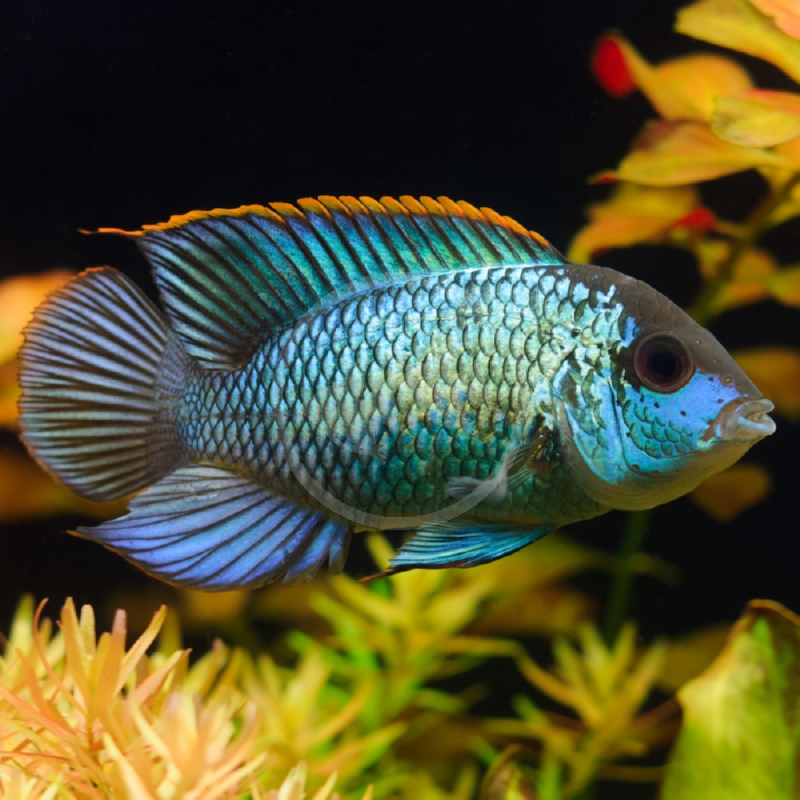
The Electric Blue Acara is an omnivorous species, which means that its diet includes both animal and plant matter. In the wild, their diet consists of small insects, crustaceans, and plant material. It is crucial to replicate this varied diet in captivity to ensure the fish receives all necessary nutrients.
- Variety is Key: A well-balanced diet is essential for the Electric Blue Acara’s overall health, growth, and coloration. Feeding a variety of foods will ensure they receive all the essential nutrients, vitamins, and minerals needed to thrive.
- Dry Pellets: High-quality commercial cichlid pellets can be used as a staple diet. These pellets are specially formulated to provide all the essential nutrients required by cichlids. Make sure to choose a pellet size appropriate for the size of the fish.
- Frozen Foods: Frozen foods like brine shrimp, bloodworms, and daphnia are excellent sources of protein and should be included in the diet regularly. These foods will help to promote growth and improve coloration. However, it is important to thaw frozen foods before feeding them to the fish.
- Live Foods: Live foods such as brine shrimp, earthworms, and small insects are a natural food source and can help stimulate the fish’s hunting instincts. However, care must be taken to ensure that live foods are free from parasites and diseases. Feeding live foods occasionally can help to vary the diet and provide essential nutrients.
- Vegetable Matter: As omnivores, Electric Blue Acaras also require plant material in their diet. Boiled vegetables like peas, spinach, and zucchini can be chopped and fed to the fish. Spirulina flakes or pellets are also a good source of vegetable matter and can be included in the diet.
- Feeding Frequency: It is recommended to feed Electric Blue Acaras 2-3 times a day with the amount they can consume within 2-3 minutes. Overfeeding should be avoided as it can lead to obesity and water quality issues.
- Diet Supplements: Supplements such as vitamins and minerals can be added to the diet to ensure the fish receives all necessary nutrients. However, if a well-balanced diet is provided, supplements are usually not needed.
It is important to note that the nutritional needs of the Electric Blue Acara may change with age, size, and breeding status. Juvenile fish require a diet higher in protein to support their rapid growth, while adult fish may require less protein and more vegetable matter. During breeding times, it may be necessary to increase the protein content of the diet to support egg production and breeding activity.
Maintaining a clean and stable environment is also crucial for the overall health and well-being of the Electric Blue Acara. Regular water changes and proper filtration will help to remove waste and maintain optimal water quality. Providing hiding spaces and plants will also help to reduce stress and provide a more natural environment.
In summary, a well-balanced diet, clean and stable environment, and proper care are essential for the health and well-being of the Electric Blue Acara. Providing a variety of foods, including dry pellets, frozen foods, live foods, and vegetable matter, will ensure the fish receives all the necessary nutrients to thrive. Monitoring the water parameters, avoiding overfeeding, and providing a suitable environment will also contribute to the fish’s overall health and longevity.
Decoration
Decorating the tank of an Electric Blue Acara requires careful planning and thoughtful consideration of their natural behaviors and preferences. These cichlids are known for their digging behavior, so the substrate and decorations should be chosen accordingly. Here are some important factors to consider when decorating the tank for an Electric Blue Acara:
- Substrate: Since Electric Blue Acaras enjoy digging, a sandy substrate is highly recommended. Sand mimics their natural environment and is gentle on their bodies. However, it is important to be careful with live plants, as the Acaras might dig them up. If you choose to add live plants, consider using plant pots or attaching them to driftwood or rocks to protect their roots from being disturbed.
- Hiding Spaces: Electric Blue Acaras, like many cichlids, appreciate plenty of hiding spaces. Providing ample hiding spots will help reduce stress and aggression among fish. Use rocks, driftwood, and plants to create natural-looking hiding spots. Make sure to arrange them in such a way that there are no sharp edges that could potentially harm the fish.
- Plants: Live plants can be used to decorate the tank and provide additional hiding spots. However, it is important to choose hardy plants that can withstand the digging behavior of the Acaras. Plants like Anubias, Java Fern, and Vallisneria are good options as they are tough and can tolerate a bit of rough treatment. Floating plants can also be a good addition as they provide shade and cover.
- Driftwood: Driftwood is an excellent addition to an Electric Blue Acara tank as it provides hiding spaces and also helps in maintaining the water pH. It can also serve as an attachment point for plants like Java Fern and Anubias. Make sure to properly clean and prepare the driftwood before adding it to the tank to remove any tannins or impurities.
- Rocks: Rocks can be used to create caves and crevices for the Acaras to hide in. It is important to choose smooth rocks without any sharp edges. Also, make sure to securely place the rocks to prevent any accidents as the Acaras may dig around them.
- Lighting: Electric Blue Acaras prefer subdued lighting. Bright lighting can cause stress to the fish. Therefore, it is recommended to use dimmable lights or add floating plants to provide some shade.
- Background: A dark background can help highlight the beautiful colors of the Electric Blue Acara. It also provides a sense of security for the fish as it mimics their natural habitat.
- Space: Electric Blue Acaras are active swimmers and require ample space to swim around. Make sure to not overcrowd the tank with decorations. Leave plenty of open swimming spaces.
It is important to remember that Electric Blue Acaras are territorial fish and may become aggressive, especially during breeding times. Therefore, it is essential to provide plenty of hiding spaces to reduce stress and aggression. Also, regularly monitor the fish’s behavior to ensure that they are not stressed or showing signs of aggression.
In summary, decorating the tank for an Electric Blue Acara requires careful consideration of their natural behaviors and preferences. Provide a sandy substrate, plenty of hiding spaces using rocks, driftwood, and plants, subdued lighting, and a dark background. Also, leave plenty of open swimming spaces and monitor the fish’s behavior regularly to ensure their well-being.
Tank Mates
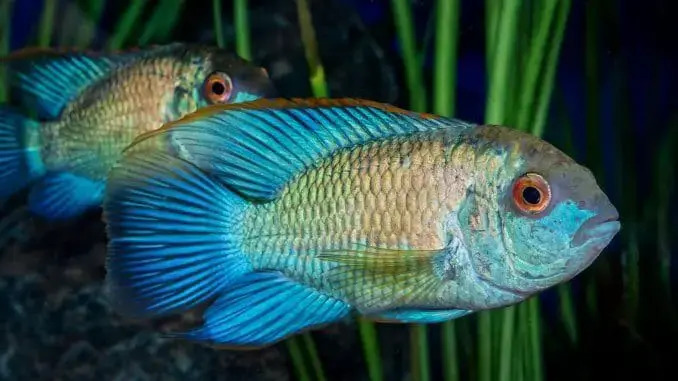
Peaceful Community
Electric Blue Acaras are relatively peaceful compared to other cichlids, which makes them suitable for community tanks. However, they can be territorial, particularly during breeding times, so it is essential to provide enough space and hiding spots for them to retreat if necessary.
Suitable Tank Mates
Tank mates should be chosen carefully to ensure compatibility. Suitable tank mates include other South American cichlids of similar size, large tetras, barbs, and catfish. It is important to avoid keeping them with small fish, as they may be seen as prey, and overly aggressive fish that may bully them. Also, ensure that the tank mates you choose are not known fin nippers, as Electric Blue Acaras have long, flowing fins that may be tempting for such fish.
Compatibility Considerations
When selecting tank mates for Electric Blue Acaras, there are several factors to consider. Firstly, consider the size of the fish. Tank mates should be of similar size to the Acaras to prevent bullying or predation. Secondly, consider the temperament of the potential tank mates. Electric Blue Acaras are relatively peaceful, but they may not tolerate overly aggressive or territorial fish. Lastly, consider the water parameters required by the potential tank mates. Electric Blue Acaras prefer soft, slightly acidic water, so it is important to select tank mates with similar water requirements.
List of Suitable Tank Mates:
- Large Tetras: Larger species of tetras, such as Congo Tetras or Bleeding Heart Tetras, can make good tank mates for Electric Blue Acaras. They are peaceful and can tolerate the water parameters preferred by the Acaras.
- Barbs: Larger barbs, such as Tinfoil Barbs or Rosy Barbs, can also be suitable tank mates for Electric Blue Acaras. However, it is important to avoid smaller, more aggressive barbs, such as Tiger Barbs.
- Catfish: Many species of catfish are suitable tank mates for Electric Blue Acaras. For example, Corydoras Catfish, Plecostomus, and Bristlenose Catfish are all good options. They are bottom dwellers and usually keep to themselves, minimizing the chances of conflicts with the Acaras.
- Other South American Cichlids: Other peaceful South American cichlids of similar size can also be suitable tank mates for Electric Blue Acaras. For example, Severum, Geophagus, and Festivum are all suitable options.
- Rainbowfish: Larger species of rainbowfish, such as Boesemani Rainbowfish or Turquoise Rainbowfish, can also make good tank mates for Electric Blue Acaras. They are active swimmers and prefer the same water parameters as the Acaras.
It is important to monitor the behavior of the fish regularly to ensure there are no signs of aggression or stress. If any signs of conflict arise, it may be necessary to separate the fish or rearrange the tank to create more hiding spaces.
In summary, Electric Blue Acaras are relatively peaceful and can be kept in a community tank with other similar-sized, peaceful fish. Suitable tank mates include large tetras, barbs, catfish, other South American cichlids, and rainbowfish. It is essential to monitor the behavior of the fish regularly and make adjustments if necessary to ensure a harmonious tank environment.
Breeding
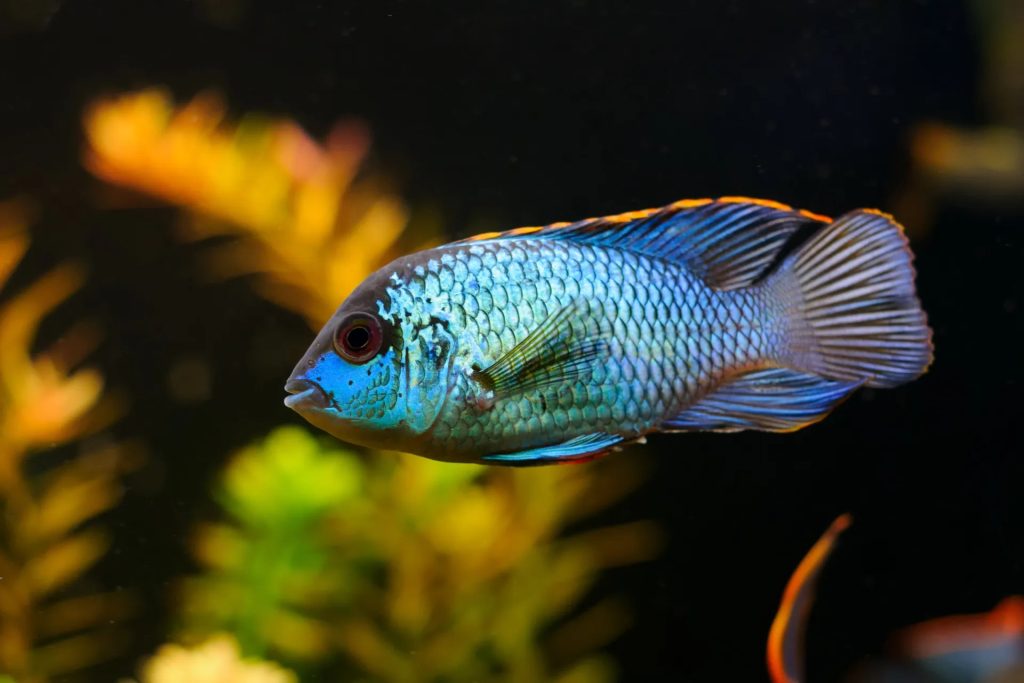
Sexing
Determining the sex of Electric Blue Acaras can be quite challenging due to the similar coloration of both males and females. However, males are generally larger in size and have more extended fins compared to females. Another subtle difference is that the males might have a more intense coloration and a somewhat more pointed dorsal fin, whereas females tend to have a rounder belly, especially when full of eggs.
Breeding Setup
It is recommended to set up a separate breeding tank to create the optimal environment for breeding. The water in the breeding tank should be soft and slightly acidic, with a pH of around 6.5-7.0. The temperature should be maintained between 77-82°F (25-28°C). Provide flat rocks or ceramic tiles as a substrate, as the pair will clean a flat surface to lay their eggs. Adding some plants can also help in making the fish feel more comfortable and secure, but leave enough open space for swimming.
Breeding Behavior
The Electric Blue Acara is a substrate spawner, which means they lay their eggs on flat surfaces. The breeding process usually begins with the pair cleaning a flat surface where the female will lay her eggs. The female typically lays between 150-300 eggs. After laying the eggs, the male will follow and fertilize them. Both parents will guard and care for the eggs and the fry once they hatch. They will often fan the eggs to provide oxygen and prevent fungus. The eggs usually hatch in about 2-3 days, and the fry will become free-swimming in about a week.
Raising the Fry
The parents usually take good care of the fry, but if you want to increase their survival rate, it is recommended to remove the fry once they start swimming and place them in a separate grow-out tank. The fry can be fed with baby brine shrimp or commercially available fry food. It is essential to provide the fry with small, frequent meals to ensure optimal growth. It is also crucial to maintain good water quality by performing regular water changes.
Remember always to monitor the water parameters and adjust the diet, tank mates, and environment accordingly. Regular water changes and proper filtration are essential to maintain optimal water quality. It is also vital to do thorough research and preparation before adding any new species to your aquarium. Knowing the specific requirements of each species will help ensure their well-being and create a harmonious environment for all the inhabitants of your aquarium.
In summary, breeding Electric Blue Acaras requires setting up a separate breeding tank with soft, slightly acidic water, and providing flat surfaces for egg-laying. The parents usually take care of the eggs and fry, but removing the fry to a separate tank and feeding them with baby brine shrimp or fry food can increase their survival rate. Regular monitoring of water parameters, proper diet, and thorough preparation are essential to ensure a successful breeding process.

